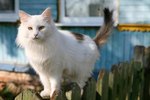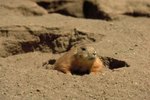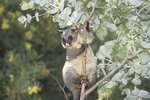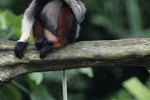
Harris's antelope (Ammospermophilus harrisii) is a species of ground squirrel that doesn't allow excessive heat to get in the way of routine activities. Harris's antelope squirrels are common in the United States' Southwest. Although these rodents are especially prevalent in western and southern portions of Arizona, they also sometimes live in New Mexico.
About Harris's Antelope Squirrels
These burrowing rodents are mostly grayish, although their undersides are white and their limbs are brownish. In the summer months, their fur typically becomes lighter. Harris's antelope squirrels are generally somewhere between 5 and 6 inches long, notes the University of Michigan's Animal Diversity Web. The furry little guys weigh, on average, a little over 4 ounces. They are diurnal, mostly solitary animals and typically inhabit dry and rugged environments. Other common monikers for these creatures are Yuma antelope ground squirrel, gray-tailed antelope squirrel, marmot squirrel and Harris's spermophile.
Diet of Harris's Antelope Squirrels
As omnivores, these squirrels consume a combination of both plant and animal nourishment. Some of their plant mealtime preferences include the fruit of cacti, seeds, roots, stems and mesquite beans. As far as cacti go, these foragers are especially fond of the cholla and barrel varieties. The omnivorous side of these small squirrels comes into play when they feed on the rotting corpses of already dead animals, bugs and small rodents.
Cheek Pouches and Food Storage
Like other species of ground squirrels, Harris's antelope squirrels possess handy cheek pouches for stashing away their newest food finds. These pouches are spacious, and once one of these squirrels arrives at his burrow, he can safely hide away his hard-earned food. Antelope squirrels also sometimes tuck their food away in other clandestine locations -- directly below rocks, for example.
Predators
It is not too common for Harris's antelope squirrels to prey on living things, but it does happen occasionally -- hello, mice. Although these squirrels aren't major predators, they're in no way immune to the dangers of predation themselves. Some of the various tough animals that often feed on antelope squirrels include bobcats, dogs, snakes, coyotes and hawks.
References
- Los Angeles Zoo and Botanical Gardens: Harris' Antelope Squirrel
- Philadelphia Zoo: Harris' Antelope Squirrel
- Desert Museum: Harris' Antelope Squirrel
- National Park Service: Harris' Antelope Squirrel
- IUCN Red List of Threatened Species: Ammospermophilus harrisii
- University of Michigan Animal Diversity Web: Ammosphermophilus harrisii
- University of Illinois Extension: Ground Squirrel
Photo Credits
-
Jupiterimages/Photos.com/Getty Images




